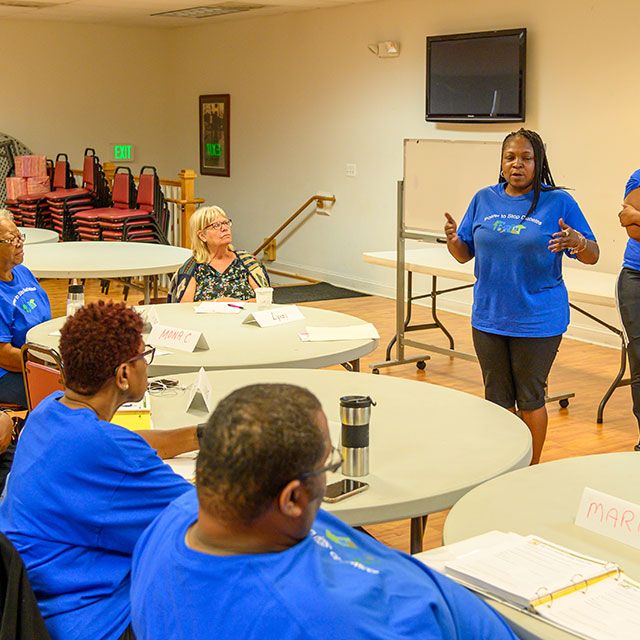Despite being diagnosed with type 1 diabetes as a child, Jason Johnson spent 11 seasons in Major League Baseball, pitching for eight different teams, including the Baltimore Orioles and the Detroit Tigers. In 2004, he became the first major leaguer to wear an insulin pump during on-field play.
His experiences are detailed in Winning with Diabetes: Inspiring Stories from Athletes to Help You Thrive, a collection of interviews with athletes, both amateur and professional, who have the disease. Written by Johns Hopkins diabetes specialist Rita Kalyani, associate professor of medicine at the Johns Hopkins University School of Medicine; clinical endocrinologist Mark Corriere, an adjunct assistant professor of medicine at the school of medicine; and Patrick Smith, a writer in the Department of Marketing and Communications at Johns Hopkins Medicine, the new book is published by the Johns Hopkins University Press.
The 16 athletes who are profiled discuss their medical challenges and explain how a diagnosis of diabetes need not be the end of athletic pursuits. Following each athlete’s story, Kalyani and Corriere provide expert commentary.
The following passage about Johnson is excerpted here, courtesy of the Johns Hopkins University Press.
AT 29, JASON JOHNSON had pitched parts of seven seasons in the major leagues. He was used to his between-innings ritual of testing his blood sugar and doing what he needed to do to avoid highs or lows.
But in 2003, he discovered that an insulin pump made managing his type 1 diabetes a lot easier. He still paid close attention to his glucose levels, but he was able to leave the finger sticks and test strips behind.
Except for when he pitched.
“It never even occurred to me to wear it on the pitcher’s mound,” he says now.
It wasn’t until the next season, as a veteran free-agent starter for the Detroit Tigers, that Johnson asked Major League Baseball to allow him to be the first big leaguer to wear an insulin pump on the field.
“Our trainer, Kevin Rand, convinced me to try it,” says Johnson.
Before the pump, Johnson’s pregame rituals included making sure his blood sugar was somewhere between 150 and 160 mg/dL. [“Milligrams per deciliter” is a unit of measure indicating the concentration of glucose in blood.] He understood that the physical and mental demands of pitching in a major league game would cause that number to fall relatively quickly.
“Any higher than that, I didn’t feel good,” he says. High glucose numbers meant that Johnson felt sluggish and tired, he says. “But I knew if I started the game at around 150, I’d be good through about three innings. After that, I’d drink a Gatorade to get my sugar back up.”
Johnson earned a reputation around the big leagues as a durable starter who could keep his team in games for six or seven innings. His diabetes didn’t affect his 11-year major league career, where he pitched for eight different teams. Johnson’s longest stints were five seasons in Baltimore and two in Detroit.
Johnson says that, before the pump, he went through about six glucose test strips a game. After pitching an inning, he’d stick his finger for a blood test. While it wasn’t common for him to need a shot of insulin during a game, he says it did happen.
“I didn’t have to do that a lot,” he recalls. “Probably four or five times.”
While normally, physical exertion would make his sugar drop, on those occasions his tests told Johnson his glucose was near 200 mg/dl.
“I can’t pitch like that. So, I would run back into the clubhouse in between innings and pray that our hitters didn’t make three quick outs. I’d fill a shot needle with insulin really quick and get back out there.”
Similarly, when Johnson felt his sugar drop, he hoped for long innings while his team was at bat. As soon as he returned to the dugout, he’d check his sugar.
“If it got down to 50 or 60” and his team’s batters made quick outs, “I was like, ‘oh man, I’m in trouble,’ ” he says. “I’d eat and drink as fast as I could before I went back out to the mound.”
One day in the spring of 2004, the Tigers trainer asked Johnson if he’d considered wearing his insulin pump when he pitched.
“I never had. I’d wear the pump all day, then right before the game I’d disconnect it,” he says. “I’d keep it in my locker and then I’d have to check my sugar between innings again.”
But when Rand brought it up, Johnson agreed it was time to petition the league to let him wear a pump.
“They told us they’d make a decision in two or three weeks,” Johnson remembers. “But it only took them three days. Major League Baseball was great about it.”
Being the first major league baseball player with diabetes to use an insulin pump while playing against the best baseball players in the world meant Johnson needed to experiment with infusion sites and the best place to attach the pump to his Tigers uniform.
He knew he had to wear the pump in a spot where it was safe from line drives. He also knew he had to insert the infusion needle under the skin on a spot on where it wouldn’t get yanked out by the extreme torque that a major league pitcher generates during his delivery.
Johnson decided to clip the pump to his belt near the small of his back, a few inches below his uniform number.
The infusion site was another matter. The small tube that leads from the infusion site to the pump needed to remain secure.
Throughout his career, Johnson was primarily a low 90s fastball pitcher, mixing in some off-speed and breaking pitches to keep hitters off balance. At 6 feet, 6 inches tall and a playing weight of about 215 pounds, Johnson relied on his body’s motion to generate the power behind his pitches.
“I had a few issues early in that season where the infusion set ripped out” and ruined the pump, recalls Johnson. “I remember thinking, when it happened, ‘Aw man! Those things aren’t cheap!’ ”
The combination of sweat and Johnson’s kinetic windup made it hard to keep his infusion set taped to his body and attached to the pump. After some experimenting, he found a better area to infuse—a spot on the back of one of his hips—and the right way to stick the tube to his skin. The tape that came with the pump wasn’t designed for athletic activity, let alone Major League Baseball. So, Johnson found a waterproof tape used in hospitals.
“I didn’t have any issues after that.”
Johnson was Detroit’s Opening Day starter against the Blue Jays that season. Wearing an insulin pump on the mound for the first time in his career, Johnson pitched six scoreless innings in Toronto’s SkyDome (now known as the Rogers Centre), earning the win against future Hall of Famer Roy Halladay.
While his team finished the 2004 season in a distant fourth place in the American League Central, Johnson posted career highs in starts (33) and innings pitched (196⅔), including a complete-game, 11-strikeout shutout in Minnesota in July. The pump was a success.




